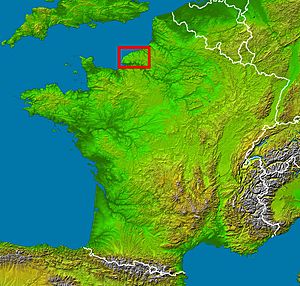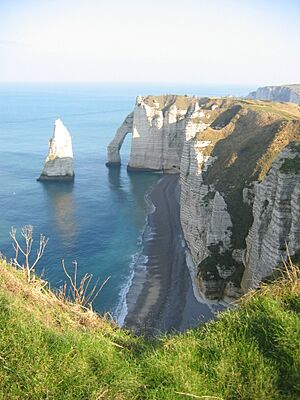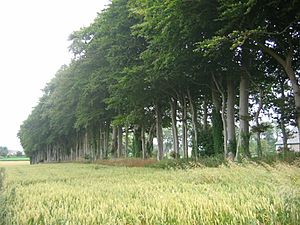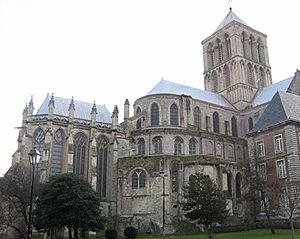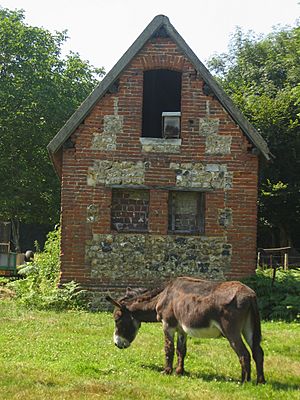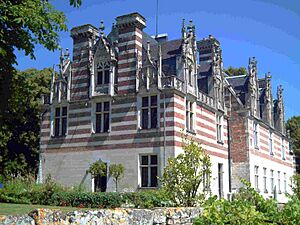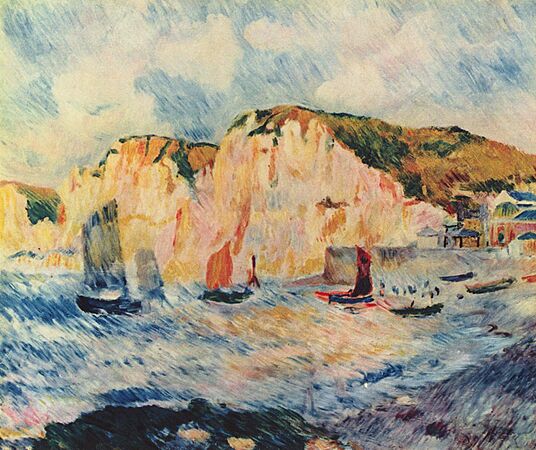Pays de Caux facts for kids
The Pays de Caux is a special area in Normandy, France. It covers most of the French region called Seine Maritime. This area is a flat, high land made of chalk, like a big table. It sits north of the Seine Estuary (where the river meets the sea) and stretches all the way to the tall cliffs along the English Channel coast. This beautiful coastline is known as the Côte d'Albâtre, or "Alabaster Coast." To the east, it meets another area called the Pays de Bray, where different kinds of soil can be seen under the chalk.
Even though the Pays de Caux has some of the best soil in France, it relies more on making things (manufacturing) than on farming. It is also famous for its lovely fabrics.
A special way of speaking called Cauchois is used here. It's a type of Norman language. The Pays de Caux is one of the last places where the Norman language is still spoken, outside of the Cotentin Peninsula. The main cities in this area are Le Havre, Dieppe, Fécamp, Yvetot, and Étretat.
In the Norman language, the word caux means lime, which is a type of calcium carbonate.
Contents
Exploring the Geography of Pays de Caux
The Pays de Caux is a high, flat area made of chalk. This chalk is similar to the chalk hills found in southern England. The land here gently rolls, but the sea has worn away the edges. This creates tall, white cliffs along the coast. Small valleys that wind inland end suddenly at these cliffs. These are called valleuses and look like deep cuts in the cliff face. Some small towns, like Étretat, are built in these valleuses. The unique rock shapes left by the sea at Étretat have inspired many artists. You can see Étretat in the picture, located in the valley beyond the first ridge.
The main towns in the northern part of the Pays de Caux are on the coast. These include Fécamp and Étretat. Dieppe is near the edge of the region. It sits on a special crack in the earth, called a geological fault. This fault helped create the deep harbor that the Vikings found when they arrived long ago. (The Swedish word for deep is djup.) The towns on the high plateau are usually small. The larger ones, like Yvetot, Bolbec, and Lillebonne, are located more to the south. They are along the main route between Rouen and Le Havre. The city of Le Havre was once part of the Pays de Caux, but it has grown into a very different kind of place.
The Pays de Caux has more people living in it than the average French region. This is because of its history of fishing along the coast. Also, growing and weaving flax (a plant used for fabric) was a traditional industry on the plateau. The ports near the Seine river mouth developed trade with cities like Rouen and Paris. More recently, cities like Le Havre have grown, and new industrial areas have been built on land reclaimed from the sea in the Seine Estuary.
The strong sea winds in this area have shaped how houses are built. Many old farmhouses are simple and plain. They are often found in farmyards that are protected by tall earth banks, walls, and a square of trees to block the wind.
Nearby Natural Areas
- Pays de Bray is to the East.
- Vexin normand is to the South-east.
- The lower Seine valley is to the South.
A Look at History
Ancient Gaul
Julius Caesar wrote about his military trips in a book called Bellum Gallicum (The Gallic War). He described a group of people called the Caletes. These people were partly the ancestors of the Cauchois people who live here today.
Roman Times
When a new highway (the A29 autoroute) was being built, archaeologists found several old Gallo-Roman villas. One important villa was at Sainte-Marguerite-sur-Mer, on the coast near Dieppe. The archaeologists found many rooms built around a square courtyard. Some rooms had beautiful mosaics on the floor. To the north, the baths and other rooms were heated by a system called hypocausts. The buildings were made from local materials like pisé (packed clay and grit), cob (a mix of earth, straw, and gravel), and timber framing. These are the same kinds of materials used in later buildings in Normandy.
Lillebonne is built on the site of the main town of the Caletes, the Gaulish tribe of this region. The Gallo-Roman town was named Juliobona under Caesar Augustus. It is famous for its old Roman theatre. Many Roman towns in Gaul were named after the Roman emperor, like Augustodunum (Autun) or Augustodurum (Bayeux). The name Julio- changed over time to Lille-. This might be because it sounded like the French word for island, île. Some experts think the original main town of the Caletes might have been Caudebec-en-Caux or Fécamp. This is based on old objects found there.
The Middle Ages
During the Merovingian period, the Pays de Caux became a separate area from Talou. The old city of the Caletes split into different "countries" or pagus, which is a Latin word for a region.
When the county of Rouen and the Duchy of Normandy were created in 911, many Viking people settled in this region. They left a lasting mark on the Cauchois dialect and on the people of Cauchois Normandy.
Manor Houses and Castles (15th and 16th Centuries)
A manoir is a large country house, often where a lord or important family lived. These houses usually weren't built like strong castles. After the Hundred Years' War, around 1450, people started rebuilding their country homes. They used local materials like flint and limestone. The owners could also add new styles from the Renaissance period.
Many Norman manoirs have a dovecote in their courtyard. A dovecote is a building where pigeons or doves are kept. Historians found 635 dovecotes in the areas of Dieppe, Le Havre, and Rouen. Most are round and made of stone. A few rare ones are polygonal or made of wood.
Some famous manoirs and châteaux (castles) include:
- Château d'Etelan, built in 1494.
- Manoir de la Bouteillerie, from 1531, with a dovecote from 1631.
- Manoir Dubocage de Bléville, built in 1516.
- Manoir de Reauté, from the 16th century, around the time of Francis I of France and Henry VIII of England.
- Manoir de Séntitot, built in 1528, known for its brick and stone with Renaissance art.
- Manoir de Vitanval, from the early 15th century, with a 16th-century dovecote. This house is made of wood with an outside staircase.
- Manoir d'Estouteville, built in the 15th century by Guillaume d'Estouteville, who was an archbishop of Rouen.
Artistic Connections
The beautiful scenery of the Pays de Caux is not far from Paris. Many famous artists, like Claude Monet and Gustave Courbet, came here to paint the landscapes and cliffs.
See also
 In Spanish: País de Caux para niños
In Spanish: País de Caux para niños


